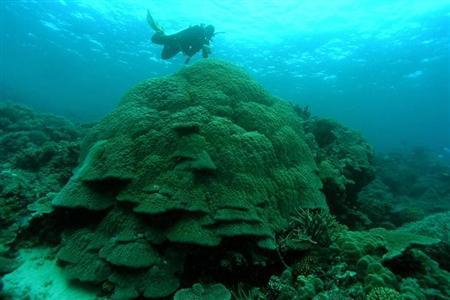
New colour purple depicts worsening climate risks in U.N. draft report
Sep 13, 2013 - By Environment Correspondent Alister Doyle - reuters.com
(Reuters) - Some parts of nature and human society are more vulnerable than expected to climate change, according to a draft of a U.N. report that adds a new purple colour to a key diagram to show worsening risks beyond the red used so far.

An Australian institute of Marine Science (AIMS) driver inspects large Porites coral on the Great Barrier Reef, in this handout photo released to Reuters on February 10, 2011. Credit: Reuters/Eric Matson/AIMS/Handout/Files
It says "unique and threatened systems" like coral reefs, endangered animals and plants, Arctic indigenous communities, tropical glaciers or small island states seem be less able to adapt to warming than believed in a last report in 2007.
The 44-page draft Summary for Policymakers by the Intergovernmental Panel on Climate Change (IPCC) looking at impacts of climate change worldwide, obtained by Reuters and dated March 2013, is part of a series of IPCC reports updating science from 2007 as the main guide for governments.
It will be issued in March 2014 in Japan after several rounds of editing by experts. "It would be misleading to draw conclusions from it," said Jonathan Lynn, spokesman for the IPCC Secretariat.
Still, the draft by the world's leading experts introduces purple to the diagram summarising risks, often called the "burning embers" since it shows vertical bars that turn red towards the top on a scale of average world temperatures rising up to an extreme of 5 degrees Celsius (9F).
The base of the five bars is white or yellow, showing lower risks, but shifts to red as temperatures rise.
"Purple colour, introduced here for the first time, reflects the assessment that unique human and natural systems tend to have very limited adaptive capacity" to rising temperatures, the draft says. And many are facing multiple threats.
The new purple replaces red at about a 2C rise over current levels to indicate extreme risks to many unique and threatened human and natural systems.
Recent scientific findings show that coral reefs, for instance, are vulnerable to death because of warming and the less well understood impact of acidification of the oceans, both linked to a build-up of carbon dioxide in the air.
And "hot spots" of diversity of endangered animals and plants may be at greater risk, partly because climate change adds to stresses such as loss of habitats, hunting and invasive species.
Almost 200 governments have agreed to work out a deal, by the end of 2015, to limit global warming to an average temperature rise of below 2.0 degrees (3.6) above pre-industrial times. Temperatures have already gained by about 0.8 degree C.
RISK PROJECTIONS
Purple is not used in the other four bars in the diagram showing key "reasons for concern", which all stay red with higher temperature rises.
They illustrate projected risks from extreme weather events, how widely damage will be spread around the world, overall costs of climate change and risks of large shifts, such as a meltdown of Greenland's ice sheet or a slowing of the Gulf Stream.
In general, the draft says that risks in these categories have not changed radically since 2007.
IPCC reports face some scrutiny, especially after the 2007 version incorrectly exaggerated the melt of Himalayan glaciers by saying they could melt by 2035. The draft 2014 summary says they will shrink but does not project a date of disappearance.
The new draft also reaffirms risks such as floods of coastal cities, a melt of permafrost in Russia or crop failures in sub-Saharan Africa. Estimated costs of adapting to climate change may be $75 billion to $100 billion a year by 2050, it says.
Drafts of the Stockholm report also show it will raise scientists' confidence that climate change since the 1950s is mainly caused by human activities - rather than natural changes - to at least 95 percent, from 90 percent in 2007.
The draft is one of four major reports by the IPCC due over the next year. The first will be issued in Stockholm on September 26, looking at the science of climate change.
"Observations don't make me more optimistic about the potential severity and consequence of climate change," said Joel Smith, of Stratus Consulting in Colorado, who developed the diagram when it was first used in an IPCC report in 2001.
Smith, who is now an IPCC author on a separate subject, said he was giving a personal opinion, not talking about the draft.
The "burning embers" were dropped from the 2007 IPCC report, partly because of objections that they were too subjective. Smith and other IPCC authors published an update in 2009 in a U.S. journal to give the diagram a stronger scientific anchor. (Editing by Mark Heinrich)

|